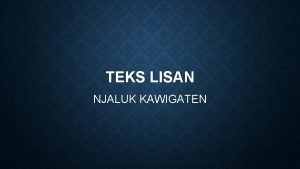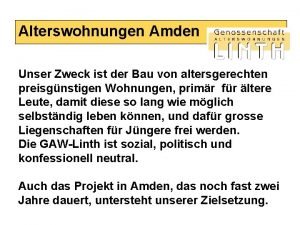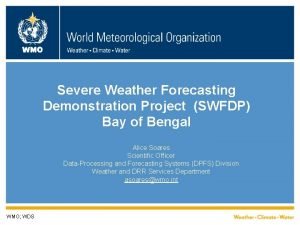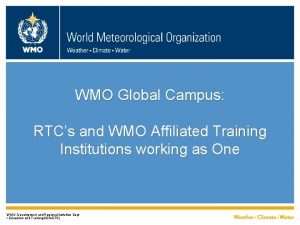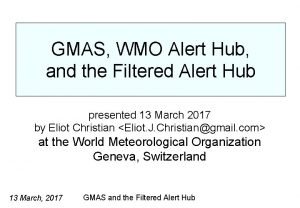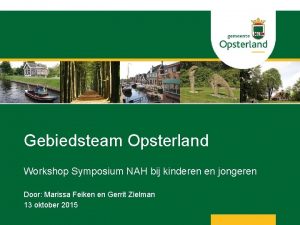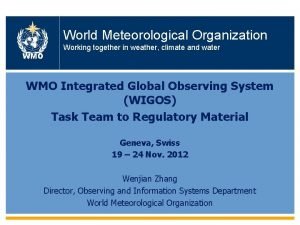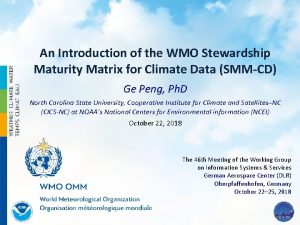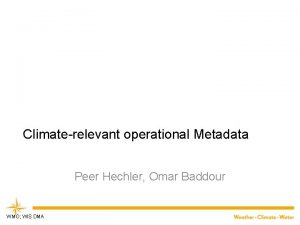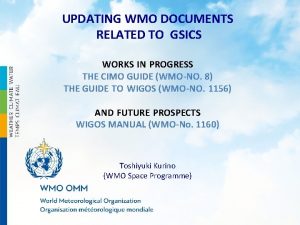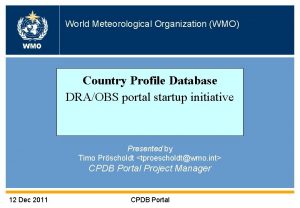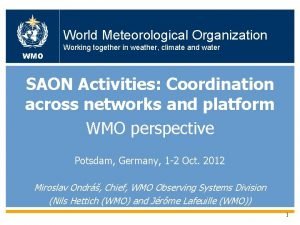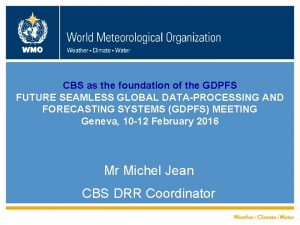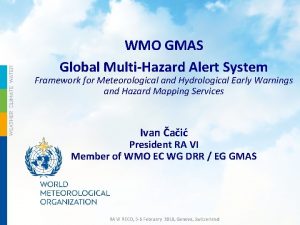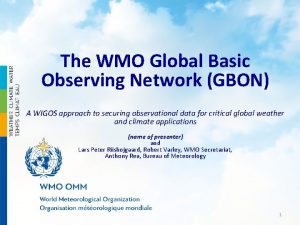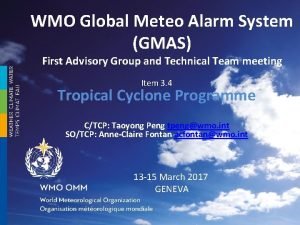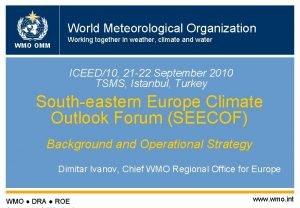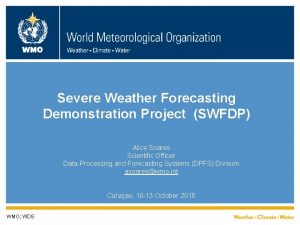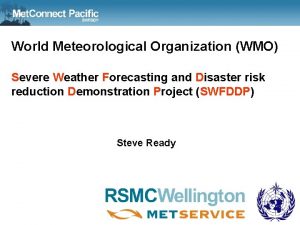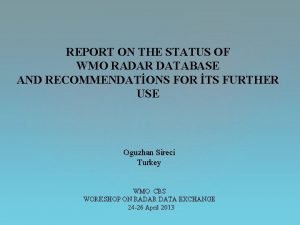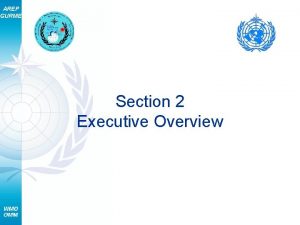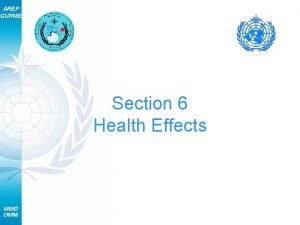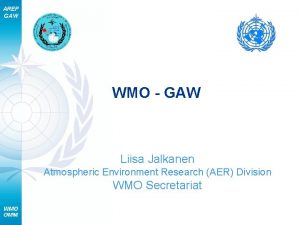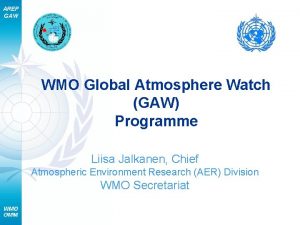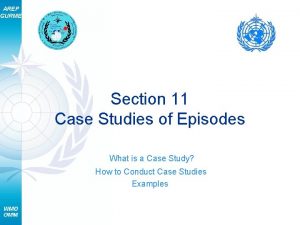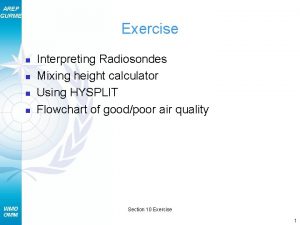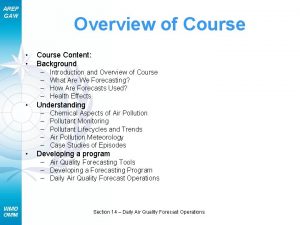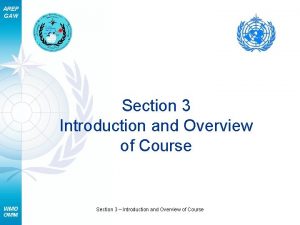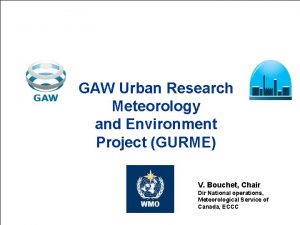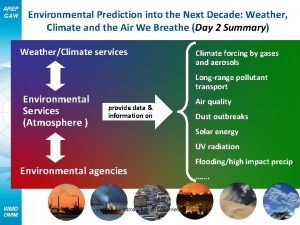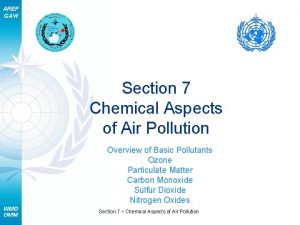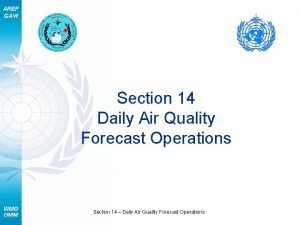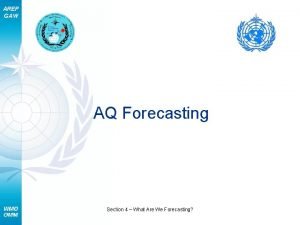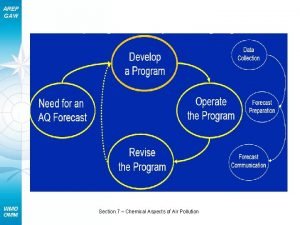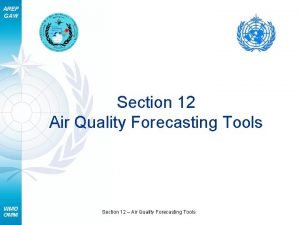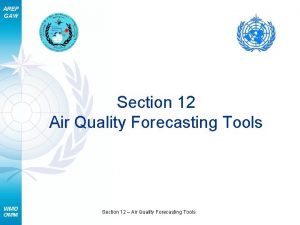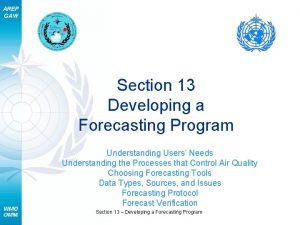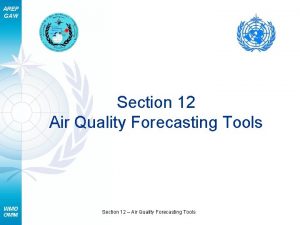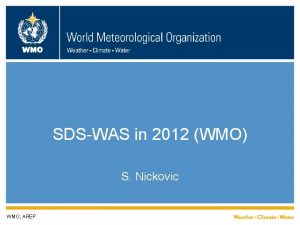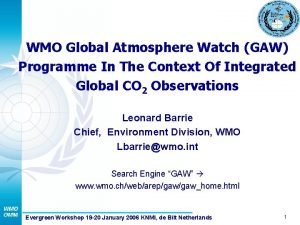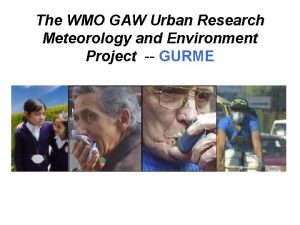AREP GAW Overview of GURME The WMO GAW























- Slides: 23

AREP GAW Overview of GURME The WMO GAW Urban Research Meteorology and Environment project Liisa Jalkanen WMO Secretariat

AREP GAW World Meteorological Organization Independent technical UN agency 187 Members manage through WMO Congress and Executive Council Secretariat in Geneva (staff 280) Technical Departments Observing and Information Systems (OBS) Climate and Water (CLW) Weather and Disaster Risk Reduction Services (WDS) Research (RES) Atmospheric Research and Environment Branch (ARE) Atmospheric Environment Research Division (AER) Global Atmosphere Watch (GAW) GURME

AREP GAW THE GAW MISSION • Systematic long-term monitoring of atmospheric chemical and physical parameters globally • Analysis and assessment • Development of predictive capability

AREP GAW observations • Stratospheric Ozone • Tropospheric Ozone • Greenhouse Gases (CO 2, CH 4, N 2 O, CFCs) • Reactive Gases (CO, VOC, NOy, SO 2) • Precipitation Chemistry • Aerosols (chemical, physical, AOD) • UV Radiation • (Natural Radionuclides, Rn 222, Be 7, 14 CO)

AREP GAW Components of the GAW Programme

AREP GAW Station Information System … GAWSIS Online - comprehensive information on all GAW stations • Database • Search / Update • Inventory / Audit (Supported by Switzerland)

AREP GAW Urban Research Meteorology and Environment GURME project

AREP GAW Urban Research Meteorology and Environment Project (GURME) • To enhance the capabilities of NMHSs and others in providing urban-environmental forecasting and air quality services of high quality, illustrating the linkages between meteorology and air quality; • To provide NMHSs and others with easy access to information on measurement and modeling techniques; • To promote a series of pilot projects to demonstrate how NMHSs and others can successfully expand their activities into urban environment issues; • In collaboration with other WMO programmes, WHO and environmental agencies, to better define meteorological and air quality measurements focusing specifically on those that support urban forecasting.

AREP GAW

AREP GAW Example of GURME project: Latin American Cities Sao Paulo, Brazil • • • Mexico City, Mexico Santiago, Chile Improvement of AQ forecasting in Latin American cities through capacity building First Air Quality Forecasting Workshop for the Latin American Cities October, 2003, Santiago, Chile; Workshop on application of WRF/Chem Model and Use of Remote sensing, 2006, Sao Paulo Training Workshop on AQF for Latin American countries, 2006, Lima NMHSs - Universities - Environmental Agencies

AREP GAW Another example: Shanghai MHEWS Shanghai is a mega-city situated on the shores of the East China Sea and the Yangtze River Mouth dense population: 18 millon l rapid economic development: aiming to be the economic, financial, trade, and transportation center of China. l. Threat of Multi-Hazard to Shanghai: frequently affected by natural hazards such as typhoons and associated marine hazards such as storm surge, heavy storms, heavy fog, heat-waves, and by atmospheric pollution episodes l Shanghai GURME project: air pollution, heat island, urban relevant meteorological measurements

Integrated Global Atmospheric Chemistry Observations WMO GAW/IGACO AREP GAW EXPO 2010 Better City, Better Life WMO has confirmed officially its participation. The pavilion is planned to have three components: - Multi-hazard early warning demonstration - Integrated global observing system - Climate change Other agreed activities: Second World Conference on Broadcast Meteorology with live weather forecast around the world during the conference (planned)

AREP GAW North Elevation A Contour-Design Description of the Pavilion named “Cloud Droplets”

AREP GAW GURME measurements: Passive Samplers Project lead: Greg Carmichael, Martin Ferm Measured gases: SO 2, NH 3, O 3, NO 2, HCOOH, CH 3 COOH, benzene, ethyl benzene, toluene, xylenes. Ideal for: Mapping concentrations in cities, siting of more advanced stations, personal monitoring. Advantages: small, no electricity needed, no inlets, large measurement range, technical personnel not needed at site, 100 % time coverage can be obtained, simple to deploy, easy to mail, inexpensive.

AREP GAW GURME FOCUS: Air Quality Modelling and Forecasting

AREP GAW GURME Air Quality Workshops • Regional Workshop (WS) on Air Quality Forecasting (AQF) August 2000, Kuching, Malaysia • Expert Workshop on AQF October 2002, Cuernavaca, Mexico • Expert WS on AQF for Latin American project October 2003, Santiago de Chile • Training WS on AQF WRF Chem and Satellites January 2006, Sao Paulo, Brazil • Training WS on (Basic) AQF for Latin American Countries July 2006, Lima, Peru • Training Course on Air Quality Forecasting for India and South Asia December 2008, Pune, India • Training Course on AQ Modelling for Latin American Cities project 10 – 14 August 2009, Mexico City

AREP GAW Important findings from the AQF workshops include: • There is growing experience and interest in air quality forecasting; • Air quality forecasting and management share a common science-base; • Improvements in AQ forecasting will come from: 1. Better understanding of local situations and of key processes (e. g. , local winds, boundary layer dynamics); 2. Increasing accuracy in the meteorological forecasts; 3. The act of doing – increased experience will lead to enhanced capability; 4. Improvements in emission estimates. GURME Experts Meeting In Cuernavaca Mexico

AREP GAW GURME Training Course Ø Develop and deliver to staff in national meteorological services, scientists and others involved in air quality issues. Ø Designed to provide the background knowledge needed to design, develop, implement and evaluate air quality modelling and/or forecasting activities. Ø The course contains practical advice, introduces the participants to available tools and methods Ø First course was developed by the GURME Training Team (GTT) and the first 5 -d training workshop was held in Lima, Peru July 2006 Ø Pune, India, course Dec 2008 new items, local experts Ø Mexico City, local and Latin American project expertise, focus on modelling and on WRF Ø Course planned to be held in Shanghai Ø Material available on the web

AREP GAW Good news is: Air quality forecast can be changed!

AREP GAW WMO large interest in early warning systems (EWS) especially multi-hazard (MH), that is: MHEWS Air pollution is part of multi-hazards GURME

AREP GAW Shifting Disaster Risk Reduction from Reaction to Prevention • Traditionally, disaster risk management approach has been focused on emergency response and recovery measures • Shifting disaster risk management to a more comprehensive approach, involving – Prevention – Preparedness and contingency (unforeseen event) planning – Emergency response and recovery measures.

AREP GAW Need for Coordination between Agencies for Development and Issuance of a Warning Message Early Detection, Monitoring and Warning Services Develop hazard monitoring and early warning services Type III Hazard fully under the mandate of NMHS Hazard under joint mandate of NMHS and other agencies Hazard under mandate of other agencies but NMHS contribute e. g. strong winds, strong rainfall, snow/ice, hail, tropical cyclone e. g. floods, air pollution, etc. e. g. locust, heathealth and epidemics, volcanic ash transport, manmade hazards Level of coordination between NMHS and other agencies

AREP GAW Collaboration critical for success!
 Bahasa kramane njaluk
Bahasa kramane njaluk Gaw linth
Gaw linth Shirley gaw
Shirley gaw Shirley gaw
Shirley gaw Wmo gdpfs
Wmo gdpfs Wmo global campus
Wmo global campus Alert hub
Alert hub Wmo consulent worden
Wmo consulent worden Stefano nativi
Stefano nativi Wmo
Wmo Introduction and acknowledgement
Introduction and acknowledgement Omar baddour
Omar baddour Cimo guide
Cimo guide Wmo country profile database
Wmo country profile database Wmo omm
Wmo omm Gdpfs wmo
Gdpfs wmo Wmo gmas
Wmo gmas Wmo gbon
Wmo gbon Gmas wmo
Gmas wmo Wmo omm
Wmo omm Wmo severe weather
Wmo severe weather Wmo severe weather
Wmo severe weather Ipcc wmo
Ipcc wmo Wmo radar database
Wmo radar database
